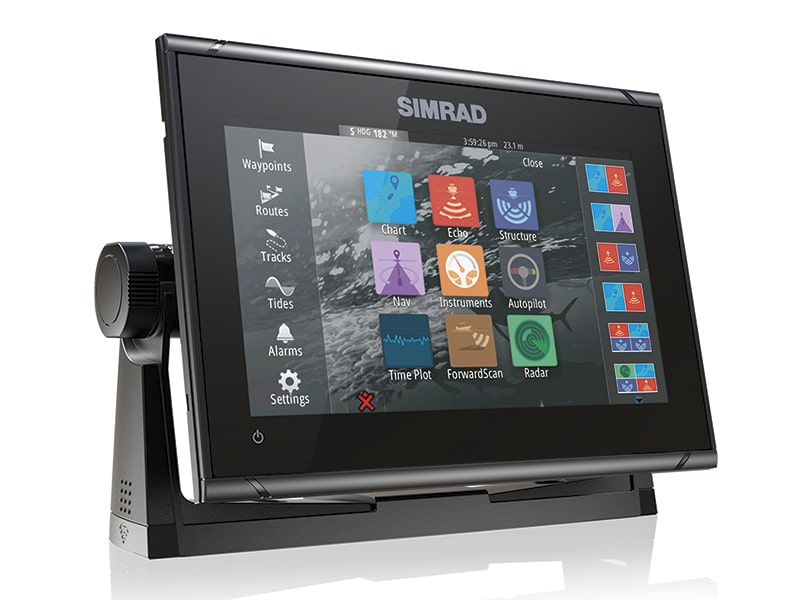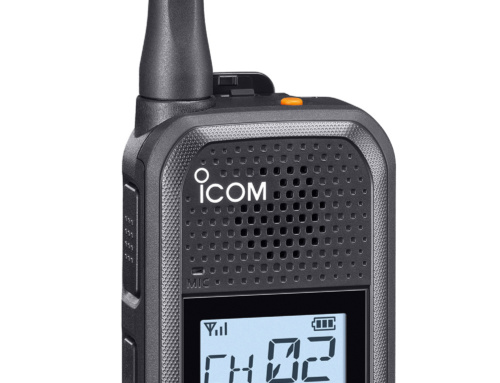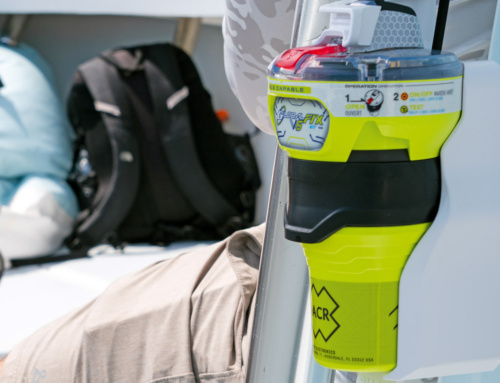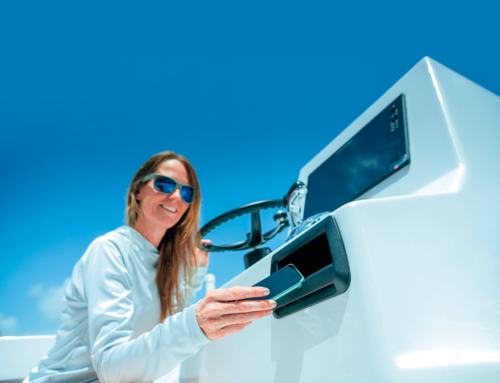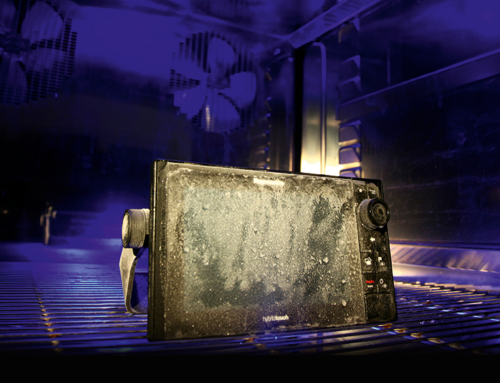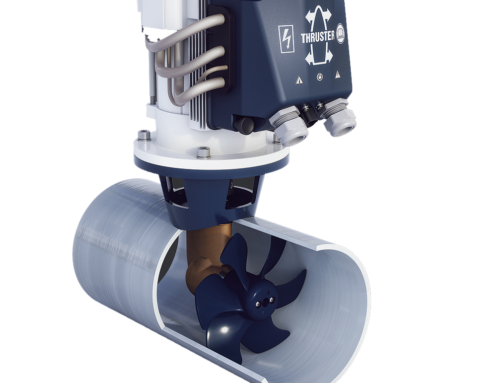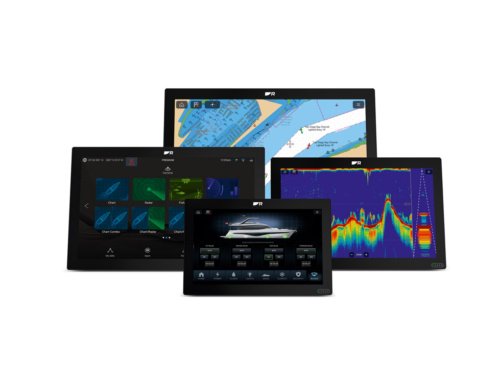- The recent sonar revolution has made sonar a considerably more effective tool for both fishermen and skippers
- Simrad have also taken system control to a new level by building a display that can actually operate in touch screen mode when wet
Electronic Evolution
Greg Copp runs his expert eyes over the latest electronic offerings from Simrad…
I recently went out with a friend in his 27ft Maxum for the first time. Going through the small-ships channel in Portsmouth he spent more time squinting at the 10-year-old plotter than he did watching the traffic crossing his bow. Leaving the harbor, he headed for the sandbank that lies to the immediate west. The reality of the situation was that with the screen brightness on maximum and with David wearing sunglasses, he could barely see the screen. Once clear of the sandbank he was keen to get to grips with the plotter’s navigational functions, but the reality was different. The screen was hard to see even without sunglasses, and the menu far from intuitive. It was clearly a no-go, and I advised David to put his Navman back on eBay and buy a modern replacement. Not that surprisingly, my words went down like a lead balloon.
The moral of the story is that today we rely on electronics for so much of our lives, from smartphones to car satnavs, that we now take this kit for granted. But with boats there is that marine dimension, which in recent years has resulted in a technology race producing a range of robust multitasking electronics that even middle-aged technophobes can get to grips with.
Like Raymarine’s new Axiom display system (PBR issue 141), Simrad’s new NSS evo3 series of HD multifunction displays are hugely versatile pieces of kit. Hot on the heels of last year’s evo2, the evo3, like its predecessor, uses a powerful quad-core processor. With plenty of punch, the evo3 can easily multitask between displaying HD charts, digital HALO radar, AIS and the multitude of sonar options now available. There is simply a host of information that is easily harnessed, combined and accessed with intuitive ease. A wide range of system options are available for a broad range of craft and budgets. As well as evo3, Simrad have launched GO9 XSE, a 9″ multi-feature display that can accommodate Simrad’s broadband radar as well as StructureScan, HD sonar and CHIRP sonar. Priced at £975 (inc. VAT), it offers an all-singing, all-dancing system for the smaller boat. Both the evo systems and the GO series of plotters (5″ – 9″) are Wi-Fi/bluetooth enabled, allowing for external viewing on a tablet or smartphone, as well as permitting the user to passage-plan at home and then upload when on board.
We were fortunate to get to grips with evo3 and GO9 XSE, along with their associated systems, in the western Solent in Tom Montgomery-Swan’s Spectre 32 race boat, as well as grabbing some time out in Simrad’s test catamaran. On such a sunny day, the brightness, colour definition and clarity of the displays in Tom’s boat were impressive, as was the angle at which you can clearly view the screens – and wearing Polaroid sunglasses is also not an issue. All of the NSS range can run on Navionics or C-MAP digital charts, though having viewed both formats I will say that when zoomed in, Navionics provides better detail, though C-MAP has more global coverage. Available in 7″, 9″, 12″ and 16″ models, the evo3 range has an easy-to-use interface, a TouchSensible touch screen keypad, pinch-to-zoom charts and a rotary‐control knob, all aimed at making the units easy to operate in all weather conditions.
The system includes expanded scrolling functionality for quick access to networked technologies like sonar, radar and VHF, while the power and MOB buttons are moved to the corners of the keypad for easier access in darkness. There is a new menu button, cursor scrolling and keypad grouping for easy and fast operation when users lock out the touch screen. There is also a programmable wheel key button that can be customised to serve a variety of personalised functions, or for direct autopilot control. Both the GO9 XSE and evo3 have a screen lock mode enabling the user to turn off touch screen when things get rough, in order to rely on rotary knob control with sub-menu selection.
Simrad produce a separate control panel that can be located remotely, which was initially developed for the evo2 system. This is a great feature for a lively powerboat where you want to stay rooted in your seat and still have control of the system. Evo3, unlike evo2, accommodates rotary controls on the right of the screen – evo 2 has none, and relies purely on the remote panel if you do not want touch screen control. Simrad have also taken system control to a new level by building a display that can actually operate in touch screen mode when wet, which as far as I am aware is a first. This was put to the test by Tom when he took a few greenies over the bow and was still able to operate his NSS evo3 displays in touch screen mode during his two-hour 100-mile passage from Torquay to Lymington.
The Software Side
One unique feature available to Mercury and MerCruiser petrol-powered boats fitted with NSS evo2 and evo3 systems is VesselView, a digital protocol gateway that converts Mercury smart craft engine data to NMEA 2000, enabling two-way communication between the engine and the NSS displays. In principle this is nothing new, as most modern chartplotters can display engine data. What is different about VesselView is that you can literally draw on screen a torque graph with your fingertips to suit your requirements. The torque is remapped by adjusting the ignition advance and the fuelling curve (engine type dependent). You can also set a speed limit on the boat. The point of both of these features is to be able to quickly custom-tune your boat for skiing and wakeboarding – ideal if the helmsman is not experienced in popping up skiers.
Built-in Wi‐Fi enables access to GoFree online services to download software updates and purchase global cartography, so there is no need to rely on buying charts in data card form from the chandlers. Being Wi-Fi enabled means smartphone and tablet control to extend the display’s reach beyond the helm. There is also the ‘Analyser Service Assistant’, which enables users to keep their entire system up to date by automatically downloading and installing the latest software, not only for the display but for all compatible modules connected by NMEA 2000 or Ethernet.
There are some interesting pieces of software available with evo3 (now available for update to evo2), the most significant being Navionics Dock-to-Dock Autorouting and SonarChart Live. SonarChart Live gives anglers the capability to create 0.5m-interval HD bathymetric maps in real time (on NSS evo2, evo3, NSO evo2 and GO XSE), showing you what the seabed really looks like.
Seabed maps are created by converting sonar returns into detailed contours, so your transducers paint an accurate up-to-date picture of what lies beneath your keel, rather than just showing the depth recorded on the digital chart. This helps raise awareness of shallow areas and reveals uncharted bottom features. It does require a Navionics mapping card with an active chart updates subscription.
Dock-to-Dock Autorouting creates intelligent and detailed routes for navigating through restricted and narrow passageways and channels. The Navionics algorithm factors in data from nautical charts and SonarChart Live, for example chart data, navigation aids and water depth, to display a suggested passage. This feature requires a Navionics card with an active chart updates subscription.
The Sonar Dimension
The recent sonar revolution has made sonar a considerably more effective tool for both fishermen and skippers. There are three elements to Simrad’s sonar dimension: StructureScan 3D, TotalScan and ForwardScan. With Simrad’s SonarHub module, two of these three sonar systems can be combined for display on multiple systems courtesy of an Ethernet connection.
StructureScan 3D is what it says it is – a 3D high-definition picture of what lies beneath you in a 180-degree arc, facing aft to a maximum depth of 600ft. The picture is painted behind you, giving you a better idea of what really sits on the seabed. You can even pan around to view from different angles, including looking up at your boat from the sea floor. NSS evo2 and evo3 can facilitate StructureScan with the appropriate StructureScan module and transducer. We got a chance to pass over a wreck, which StructureScan showed up as a long dark object. As it was probably covered in sand or mud, apart from the shape, it was impossible to specifically identify it as a wreck, but then StructureScan can only identify what is visible to its sonar transmission.
TotalScan is a stand-alone, all-in-one 83/200hz transducer that combines broadband/CHIRP sonar with StructureScan HD and DownScan imaging to 600ft. This jack-of-all-trades transducer also benefits from Simrad’s latest software known as ‘Time Variable Gain’, which reduces on-screen ‘clutter’ produced by wave action at the surface, enabling shallow fish to be more easily identified. This should prove a popular system, as apart from painting an accurate 2D horizontal seabed picture and 2D vertical depth profile of the bottom, it is easily fitted with a through-hull or transom transducer, and can be paired with the GO5/GO7/GO9 XSE, evo3 and SonarHub.
HALO radar
HALO radar is Simrad’s latest digital radar. In simple terms, it offers the best of both worlds. Though Simrad’s broadband radar is still available, HALO offers a greater range out to 7nm. Broadband radar has slightly better short-range clarity, but the advantage is minimal. When coming into Lymington, the HALO radar fitted to the test catamaran accurately identified the various boats and pile moorings at close range. It has ‘beam sharpening technology’, which improves the picture of adjacent objects in crowded anchorages. The screen display can be split into both extreme close range and long range out to its maximum if need be. For sport fishing enthusiasts, HALO has ‘BIRD’ mode, making it possible to locate feeding flocks from several miles without high-gain screen clutter.
Contact

